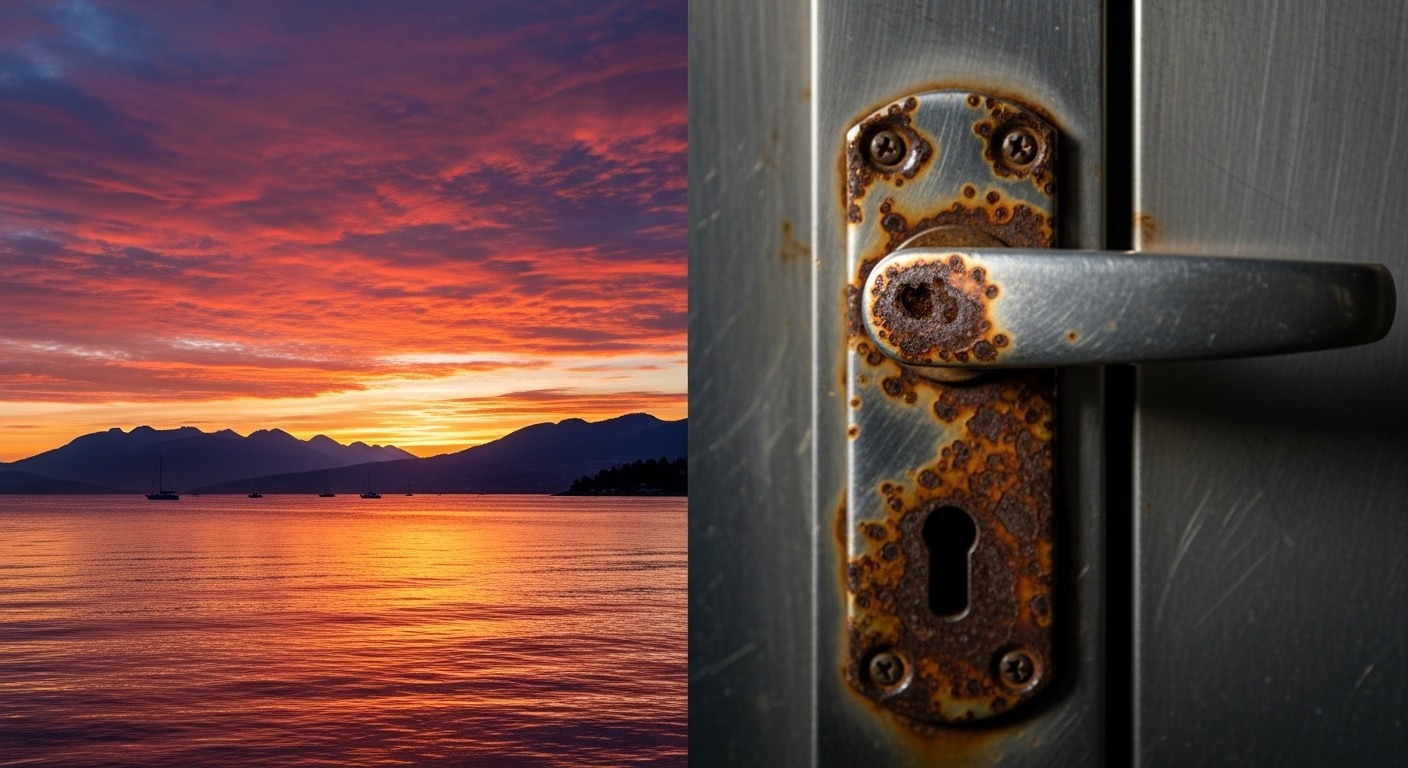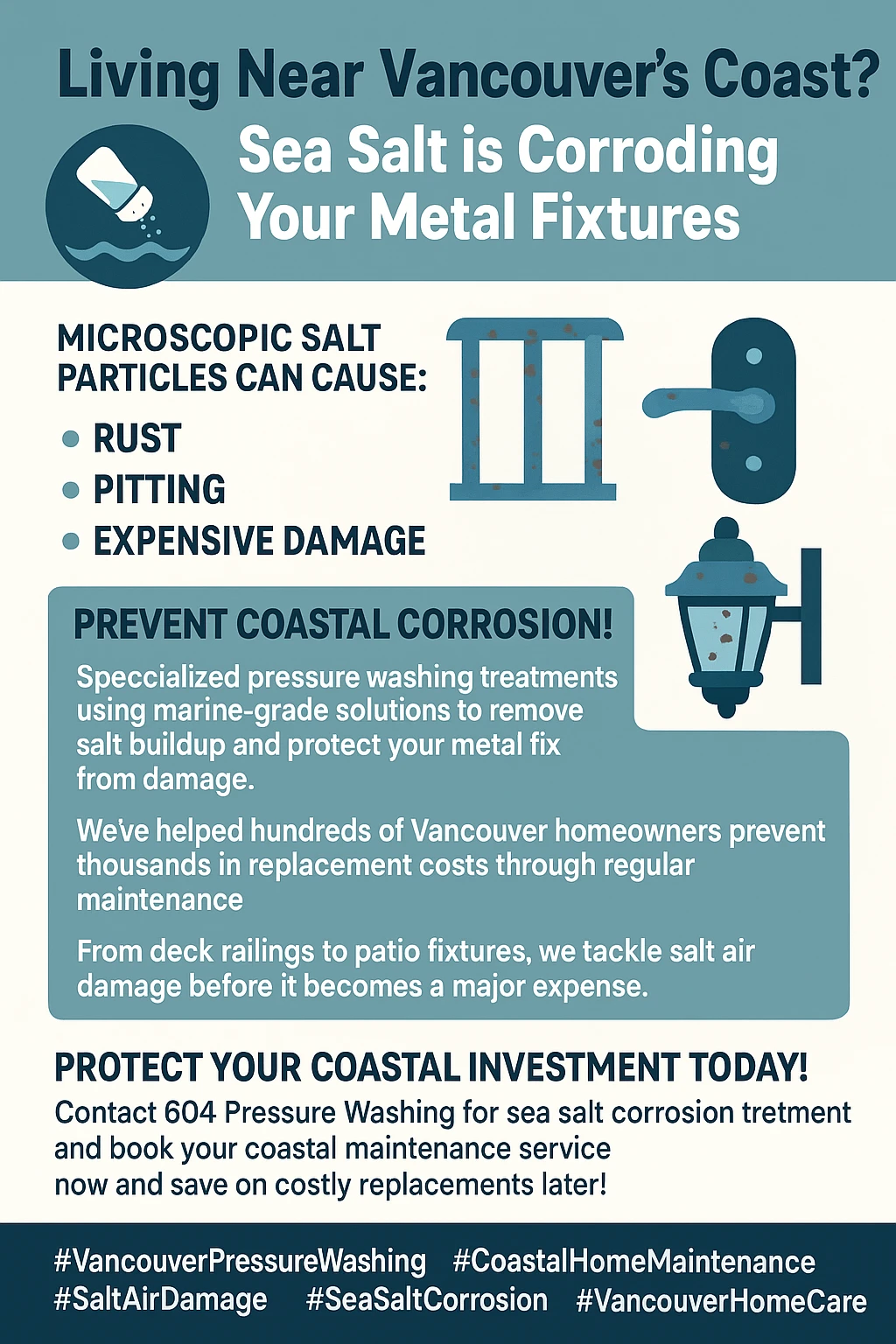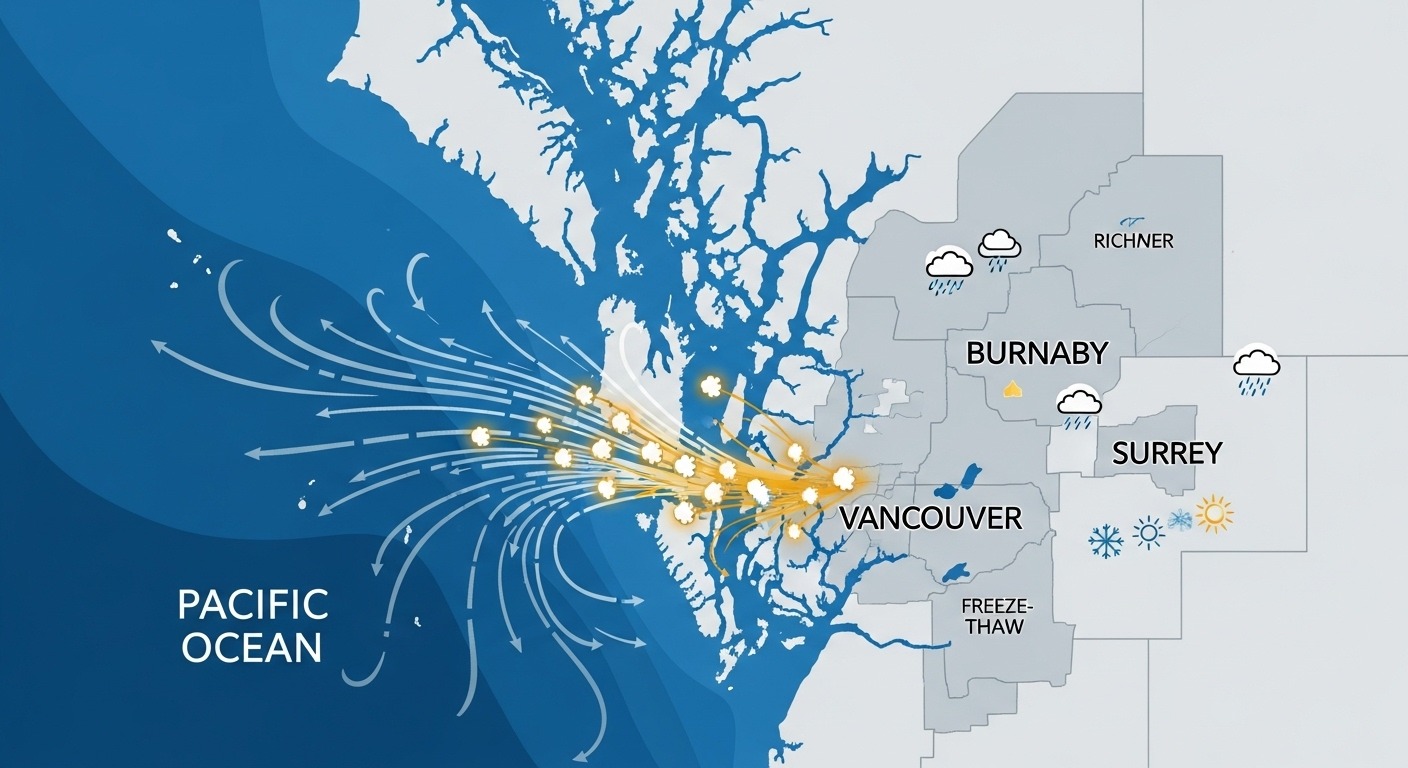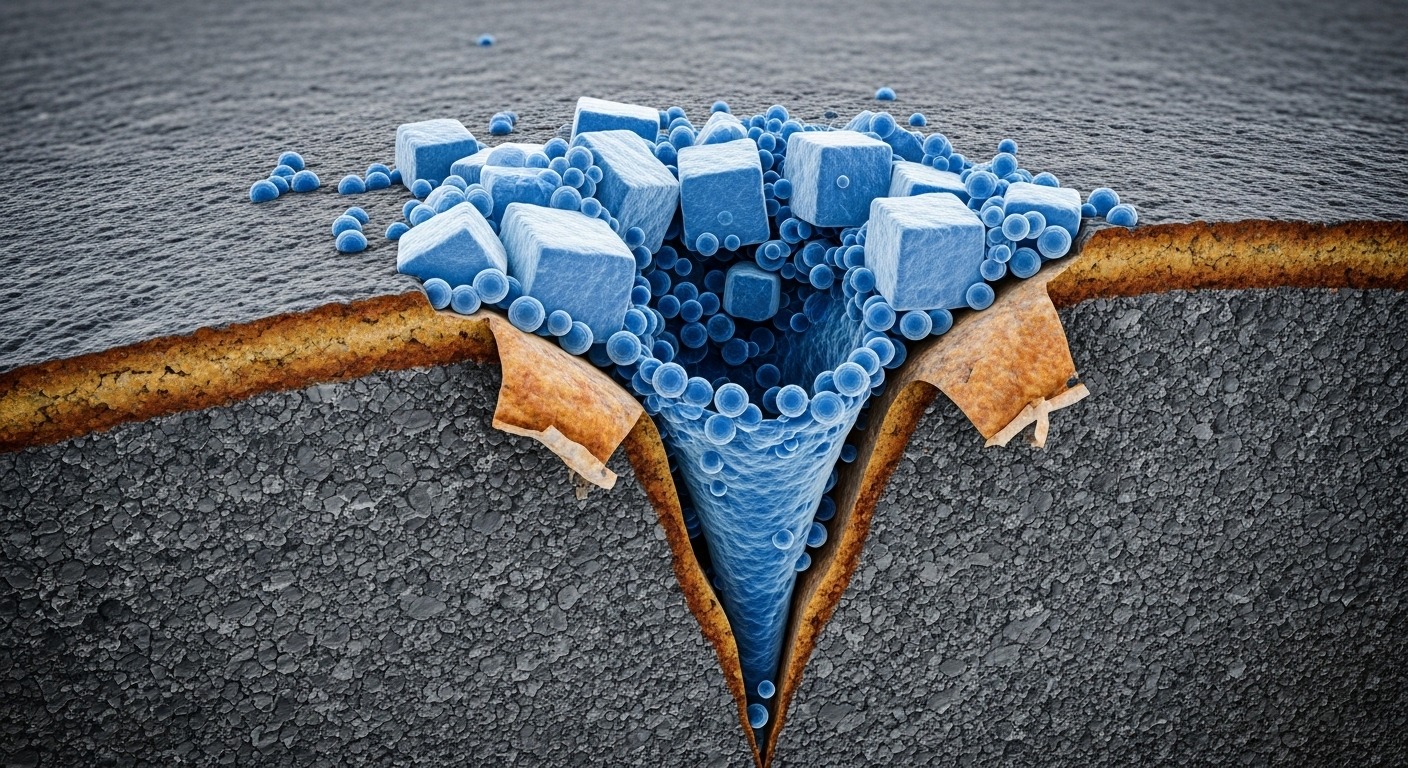Why Vancouver’s Sea Salt Air is Corroding Your Home’s Metal Fixtures (And How Pressure Washing with Specialized Solutions Prevents Expensive Replacements)
Ever wondered why your beautiful Vancouver home’s metal fixtures seem to deteriorate faster than expected, despite our mild West Coast climate? The same salt-laden ocean breezes that create those Instagram-worthy sunsets are quietly launching a 24/7 chemical assault on every piece of metal around your property, potentially costing you thousands in premature replacements if left unchecked.Picture this scenario that plays out in Vancouver neighborhoods daily: you’re sipping your morning coffee while admiring that gorgeous North Shore mountain view when you notice your three-year-old stainless steel door handle has developed unsightly brown spots, your mailbox numbers are looking mysteriously corroded, and those expensive outdoor light fixtures you installed last spring already show signs of pitting and rust. What you’re witnessing isn’t manufacturing defects or bad luck – it’s the direct result of Vancouver’s coastal environment waging a silent war against every metal surface on your property. The microscopic salt particles carried by our ocean winds don’t just create that fresh sea smell; they’re systematically breaking down the protective barriers on your metal fixtures, accelerating corrosion at rates that would shock most homeowners.  This isn’t just a cosmetic issue that affects curb appeal, though the visual impact certainly matters in Vancouver’s competitive real estate market. The salt air corrosion process penetrates deep into metal structures, compromising the integrity of essential fixtures and creating safety hazards that extend far beyond surface-level staining. From door hinges that suddenly seize up during winter storms to outdoor electrical fixtures that develop dangerous corrosion around connection points, the effects of coastal salt exposure create both immediate inconveniences and long-term structural concerns. Understanding the science behind this process and implementing targeted prevention strategies through specialized pressure washing can dramatically extend the life of your metal fixtures while protecting your property investment from Vancouver’s beautiful but chemically aggressive marine environment.
This isn’t just a cosmetic issue that affects curb appeal, though the visual impact certainly matters in Vancouver’s competitive real estate market. The salt air corrosion process penetrates deep into metal structures, compromising the integrity of essential fixtures and creating safety hazards that extend far beyond surface-level staining. From door hinges that suddenly seize up during winter storms to outdoor electrical fixtures that develop dangerous corrosion around connection points, the effects of coastal salt exposure create both immediate inconveniences and long-term structural concerns. Understanding the science behind this process and implementing targeted prevention strategies through specialized pressure washing can dramatically extend the life of your metal fixtures while protecting your property investment from Vancouver’s beautiful but chemically aggressive marine environment.
Key Outtakes:
- Vancouver’s coastal climate reduces metal fixture lifespans by 20-40% compared to inland locations due to salt air penetration and humidity damage
- Salt particles travel up to 25 kilometers inland during storms, affecting homes in Burnaby, Richmond, and Surrey with measurable corrosion damage
- Specialized pressure washing with salt-neutralizing solutions can extend metal fixture life by 3-5 years when performed twice annually
- Professional maintenance costs significantly less than replacement, with preventive pressure washing averaging $400-800 yearly versus metal fixture replacements costing $4,000-12,000 every 5-7 years
- Vancouver’s freeze-thaw cycles combined with salt exposure create triple-threat conditions requiring specific timing and techniques for effective corrosion prevention

Understanding Vancouver’s Unique Marine Environment and Metal Fixture Vulnerability
Living in Vancouver means accepting that our stunning coastal location comes with environmental challenges that most inland homeowners never face, and understanding these unique conditions is crucial for protecting your property investment. Vancouver’s position between the Pacific Ocean and the Coast Mountains creates distinctive wind patterns that carry salt particles up to 25 kilometers inland during storms, while the surrounding topography traps moisture-laden air that keeps humidity levels consistently elevated throughout our notorious rainy season. This geographical setup means that even homes in areas like Burnaby, Richmond, and Surrey experience salt air exposure levels that can cause measurable corrosion damage over time.  The triple threat of environmental conditions in Vancouver creates a perfect storm for metal fixture deterioration that goes far beyond what you’d expect from a “mild” West Coast climate. The combination of salt-laden air, persistently high humidity levels that exceed 60% during our extended rainy season, and frequent freeze-thaw temperature cycles work together synergistically to accelerate metal breakdown at rates that are far more destructive than any single environmental factor operating alone. This explains why fixtures that might last 15-20 years in Calgary or Saskatoon often begin showing significant corrosion damage within 5-8 years in Vancouver’s coastal environment.What makes Vancouver’s situation particularly challenging for homeowners is how our marine climate creates invisible microzone variations that affect different neighborhoods with surprising intensity differences. Properties within 5 kilometers of the waterfront experience corrosion rates that are three times higher than homes just 10 kilometers further inland, while areas in Richmond and south Burnaby face elevated risks due to their proximity to Fraser River salt marshes and the prevailing southwestern wind patterns that carry marine aerosols directly over these communities. These microclimatic variations mean that two homes separated by just a few kilometers can experience dramatically different rates of metal fixture deterioration.The seasonal dynamics of Vancouver’s salt air exposure create additional complexity for homeowners trying to understand when their fixtures are most at risk. During winter Pacific storm systems, salt particle concentrations in the air can spike to levels 5-10 times higher than summer averages, with these particles remaining suspended in the atmosphere for days after storms pass. The persistence of these corrosive conditions means that metal fixtures continue to be exposed to damaging salt concentrations even during seemingly calm periods, making year-round protection essential rather than optional.Understanding the specific vulnerability factors that make certain metal fixtures more susceptible to Vancouver’s coastal environment helps homeowners prioritize their maintenance efforts and budget appropriately for potential replacements. Door handles, mailboxes, house numbers, outdoor electrical fixtures, and decorative railings represent the highest-risk components because they combine maximum exposure to salt air with materials and designs that create ideal conditions for corrosion initiation. Even fixtures labeled as “marine grade” or “weather resistant” can suffer significant degradation in Vancouver’s aggressive coastal climate without proper maintenance and protection strategies.
The triple threat of environmental conditions in Vancouver creates a perfect storm for metal fixture deterioration that goes far beyond what you’d expect from a “mild” West Coast climate. The combination of salt-laden air, persistently high humidity levels that exceed 60% during our extended rainy season, and frequent freeze-thaw temperature cycles work together synergistically to accelerate metal breakdown at rates that are far more destructive than any single environmental factor operating alone. This explains why fixtures that might last 15-20 years in Calgary or Saskatoon often begin showing significant corrosion damage within 5-8 years in Vancouver’s coastal environment.What makes Vancouver’s situation particularly challenging for homeowners is how our marine climate creates invisible microzone variations that affect different neighborhoods with surprising intensity differences. Properties within 5 kilometers of the waterfront experience corrosion rates that are three times higher than homes just 10 kilometers further inland, while areas in Richmond and south Burnaby face elevated risks due to their proximity to Fraser River salt marshes and the prevailing southwestern wind patterns that carry marine aerosols directly over these communities. These microclimatic variations mean that two homes separated by just a few kilometers can experience dramatically different rates of metal fixture deterioration.The seasonal dynamics of Vancouver’s salt air exposure create additional complexity for homeowners trying to understand when their fixtures are most at risk. During winter Pacific storm systems, salt particle concentrations in the air can spike to levels 5-10 times higher than summer averages, with these particles remaining suspended in the atmosphere for days after storms pass. The persistence of these corrosive conditions means that metal fixtures continue to be exposed to damaging salt concentrations even during seemingly calm periods, making year-round protection essential rather than optional.Understanding the specific vulnerability factors that make certain metal fixtures more susceptible to Vancouver’s coastal environment helps homeowners prioritize their maintenance efforts and budget appropriately for potential replacements. Door handles, mailboxes, house numbers, outdoor electrical fixtures, and decorative railings represent the highest-risk components because they combine maximum exposure to salt air with materials and designs that create ideal conditions for corrosion initiation. Even fixtures labeled as “marine grade” or “weather resistant” can suffer significant degradation in Vancouver’s aggressive coastal climate without proper maintenance and protection strategies.
The Science Behind Accelerated Metal Corrosion in Coastal Vancouver
The seemingly harmless salt air that gives Vancouver its distinctive coastal character is actually launching a sophisticated chemical assault on your metal fixtures through a process that operates 24 hours a day, 365 days a year, regardless of weather conditions. Understanding the electrochemical corrosion process reveals why salt particles don’t simply sit harmlessly on metal surfaces but instead actively attract moisture from the surrounding air to create electrolytic conditions that promote galvanic corrosion between different metals within the same fixture. This process occurs because saltwater conducts electricity far more effectively than freshwater, allowing electrons to move more easily away from metal atoms and causing the fundamental atomic structure of the metal to break down over time.The microscopic salt particles that arrive via Vancouver’s ocean winds initiate what corrosion scientists call “pitting corrosion,” a particularly destructive form of metal degradation that eats through components from the inside out. Chloride ions from sea salt interfere with metals’ natural ability to form protective oxide layers, creating localized areas where accelerated corrosion can penetrate deeply into the metal substrate while leaving surrounding areas relatively unaffected. This process explains why salt-air corrosion often manifests as small, dark pits that seem to appear suddenly on metal surfaces, representing the visible evidence of extensive subsurface damage that has been progressing invisibly for months or years.  Vancouver’s temperature cycling patterns amplify the destructive effects of salt air exposure through a mechanical process that compounds the chemical corrosion damage. The frequent transitions between near-freezing nighttime temperatures and mild daytime conditions that characterize our maritime climate cause repeated expansion and contraction of metal components, gradually loosening connections, cracking protective seals, and creating micro-pathways that allow salt-contaminated moisture to penetrate deeper into fixture assemblies. These thermal stress cycles work in conjunction with the ongoing chemical attack from salt deposits to accelerate the breakdown of metal fixtures at rates that often surprise homeowners who assume their coastal climate is “gentle” compared to harsher continental environments.The persistence of corrosive conditions in Vancouver’s coastal environment means that salt damage continues to progress even during periods when no fresh salt deposition is occurring. Once salt crystals establish themselves on metal surfaces, they continue to attract atmospheric moisture and maintain localized corrosive conditions long after the initial salt exposure event has passed. This characteristic of salt corrosion explains why fixtures can continue to deteriorate rapidly even during Vancouver’s relatively dry summer months, as existing salt deposits work continuously to draw moisture from the air and sustain the electrochemical processes that drive metal degradation.The interaction between different metals commonly found in architectural fixtures creates additional corrosion vulnerabilities specific to Vancouver’s salt air environment. When dissimilar metals like aluminum, steel, and brass are used together in outdoor fixtures – a common design practice for aesthetic reasons – the salt-contaminated moisture essentially creates a battery effect that accelerates the corrosion of the more reactive metal components. This galvanic corrosion process can cause catastrophic failure of critical structural elements while leaving decorative components relatively unaffected, creating safety hazards that may not be
Vancouver’s temperature cycling patterns amplify the destructive effects of salt air exposure through a mechanical process that compounds the chemical corrosion damage. The frequent transitions between near-freezing nighttime temperatures and mild daytime conditions that characterize our maritime climate cause repeated expansion and contraction of metal components, gradually loosening connections, cracking protective seals, and creating micro-pathways that allow salt-contaminated moisture to penetrate deeper into fixture assemblies. These thermal stress cycles work in conjunction with the ongoing chemical attack from salt deposits to accelerate the breakdown of metal fixtures at rates that often surprise homeowners who assume their coastal climate is “gentle” compared to harsher continental environments.The persistence of corrosive conditions in Vancouver’s coastal environment means that salt damage continues to progress even during periods when no fresh salt deposition is occurring. Once salt crystals establish themselves on metal surfaces, they continue to attract atmospheric moisture and maintain localized corrosive conditions long after the initial salt exposure event has passed. This characteristic of salt corrosion explains why fixtures can continue to deteriorate rapidly even during Vancouver’s relatively dry summer months, as existing salt deposits work continuously to draw moisture from the air and sustain the electrochemical processes that drive metal degradation.The interaction between different metals commonly found in architectural fixtures creates additional corrosion vulnerabilities specific to Vancouver’s salt air environment. When dissimilar metals like aluminum, steel, and brass are used together in outdoor fixtures – a common design practice for aesthetic reasons – the salt-contaminated moisture essentially creates a battery effect that accelerates the corrosion of the more reactive metal components. This galvanic corrosion process can cause catastrophic failure of critical structural elements while leaving decorative components relatively unaffected, creating safety hazards that may not be

